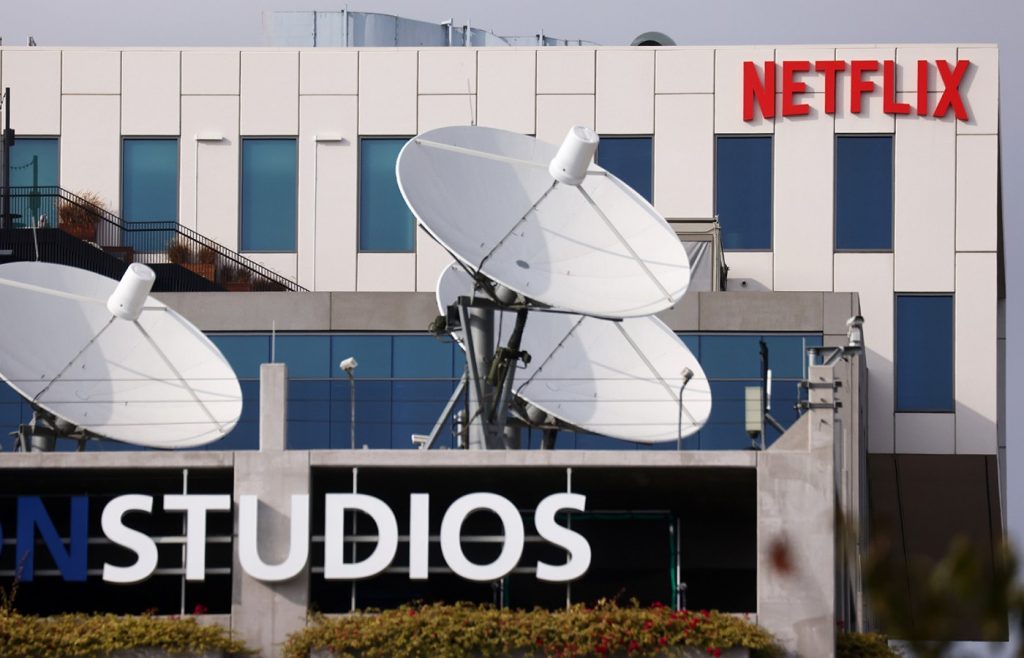LOS ANGELES — Four years ago, Netflix was faced with a formidable challenge to its dominance. Competitors including Walt Disney Co. and Warner Bros. Discovery invested billions of dollars to chip away at Netflix’s market share by launching splashy shows on their own streaming services.
For a time, it seemed that Netflix was vulnerable. The company lost subscribers for two straight quarters in 2022 despite gargantuan spending, raising concerns that its growth had plateaued.
But lately the tide has turned. Netflix has managed to maintain its position as the leader in subscription streaming, with 260 million paying customers worldwide, far more than its direct competitors. Netflix added more than 13 million subscribers during the fourth quarter. The Los Gatos, California-based company’s stock has surged roughly 90% during the last year.
As a result, many analysts have made a bold proclamation in recent months. The so-called streaming wars are over, they say. Netflix has won. As evidence, they point to rival studios that are now licensing more of their programs to Netflix, including HBO’s “Six Feet Under” and “Insecure,” after years of holding onto their big action movies and popular shows for their own platforms.
“Their competitors are so desperate to make money, they’re giving this content to Netflix,” said Jeffrey Wlodarczak, chief executive of Pivotal Research Group. “This is what winning is.”
Netflix executives, for their part, sound as confident as ever, even as the company continues to make changes, including a recent shakeup in its film business. There’s much more runway for Netflix to grow, Spencer Neumann, Netflix’s chief financial officer, said at a Morgan Stanley conference in San Francisco on Monday.
“We are just getting started,” Neumann said. “Now we’re small in every measure. Every way we look at it, we’re less than 10% of the view share in every country in which we operate, and that’s a pretty small slice of pie.”
How did Netflix defend its bulwark when there are still multiple streaming services fighting for eyeballs?
The streamer has cracked down on password sharing, offering a cheaper ad-supported plan for cost-conscious viewers. Added restrictions on viewers who were borrowing Netflix accounts got people to buy their own subscriptions, helping the company increase net income to $938 million in the fourth quarter, compared to $55 million a year ago, while revenue rose 12.5% to $8.8 billion.
Since then, Disney’s Hulu, Disney+ and ESPN+ and Warner Bros. Discovery’s Max also have signaled they will tighten their limits on password sharing.
Netflix also diversified its content beyond scripted programs, adding more reality TV shows, non-English-language originals, live TV, games and sports documentaries to its mix.
And Netflix expanded its sports-related content. In January, the streamer announced it would become the exclusive host to WWE’s weekly pro wrestling show “Raw” in 2025, which analysts say will help boost Netflix’s advertising business and increase WWE’s global reach outside the U.S. “Raw” is the top show on the USA Network, where it brings in 17.5 million unique viewers over the course of the year, WWE and Netflix said.
“Introducing it to a new set of fans as well as servicing the existing fans that are either already Netflix subscribers, or will come over, to me either way is a win,” Brandon Riegg, vice president of nonfiction series at Netflix, said at a press event in Hollywood in January. “The truth is we don’t know how much bigger it can get. I think we’re all really bullish on it.”
A significant factor in Netflix’s lead is that it had a major head start, entering the streaming arena in 2007, much earlier than many of its Hollywood competitors. It set up production hubs in different countries around the world, including South Korea, where Netflix has had success with a pipeline of K-dramas that can be dubbed into many different languages. The company also built a robust platform with recommendations based on a user’s past viewing habits, with trailers and titles promoted tailored to their tastes.
“They built scale quicker than anybody else, and that scale in turn leads to a shorter road for a new original to become a hit because they have such a wider audience available to sample,” said Brandon Katz, industry strategist for Parrot Analytics. “They have done a very good job of maintaining their market-leading position in the streaming industry, even as competition and macroeconomic industry factors have thrown a lot of challenges at them.”
Meanwhile, Wall Street started to turn on legacy media companies including Disney, Paramount and Warner Bros. Discovery, which had sacrificed traditional television and box office revenue to fuel their streaming ambitions. Stock market pressure encouraged those businesses to rein in their spending on direct-to-consumer operations.
Even Walt Disney Co. Chief Executive Bob Iger acknowledged Netflix’s technological prowess at a Morgan Stanley conference on Tuesday.
“We’re now in the process of creating and developing all of that technology, and obviously the gold standard there is Netflix,” Iger said.
“We need to be at their level in terms of technology capability.”
Disney+ has 111.3 million subscribers as of its first fiscal quarter (excluding Disney+ Hotstar). Warner Bros. Discovery counts 97.7 million subscribers in its direct-to-consumer category, which includes Max, HBO, Discovery+ and premium sports product in the fourth quarter.
Netflix also resolved some analyst concerns about its debt levels. In 2021, the streamer said it would no longer need to raise external financing for its day-to-day operations.
And while last year’s six months of Hollywood strikes hobbled film and TV production and thinned out studios’ TV and movie schedules, Netflix appeared to weather the disruption better than many rivals.
Related Articles
7 awesome Bay Area things to do this weekend
Shake Shack has free burgers for Oscar nominees — and maybe you
Why Bradley Cooper won’t bring his new girlfriend Gigi Hadid to the Oscars
Oscars producers promise surprises for Sunday’s (1 hour earlier) show
Steven Spielberg, Ariana Grande, Anya Taylor-Joy added to Oscars lineup. Here’s more on how to watch
Striking writers and actors raised concerns about streaming services, blasting Netflix and others for not financially rewarding them enough when programs became hits. They demanded more data transparency and substantial increases in pay. Some people in the industry called last summer’s labor stoppages the “Netflix strike,” citing changes the company popularized in how the entertainment industry does business. Many productions, including work on the upcoming seasons for “Stranger Things” and “Cobra Kai,” were delayed due to the labor stoppages.
The Writers Guild of America and SAG-AFTRA were able to achieve many of their aims in their new contracts. Nonetheless, Netflix continued to increase its subscriber base during the strikes. One of the titles that gained traction on Netflix over the summer was the legal drama “Suits,” a USA Network series that ran from 2011 to 2019 but gained a new surge of cultural relevance last year when it appeared on the service.
Production overseas also helped, as it is usually less expensive than producing programs in the U.S., analysts said.
“You can see how the content budget would get more bang for its buck if they could actually produce a ‘Squid Game’ every year here in America,” Katz said. “The more they’re able to get some of that South Korean programming, Indian programming, Spanish-language programming, to really kind of pop on the charts here in America, the longer their dollar goes, the less they have to rely on more costly American-made series.”
Two years ago, the future of Netflix was murkier as it navigated a correction in the streaming industry. At the start of the pandemic, streamers including Netflix saw massive growth as people sheltered at home and looked for ways to entertain themselves. But eventually the subscriber growth slowed down, with Netflix reporting a decline in customers in the first half of 2022. The hiccup was startling to investors, considering the sums the company was spending on content, and the stock tumbled.
Netflix laid off hundreds of workers and began investing in new areas of business, including launching an ad-supported streaming plan, after years of being averse to commercials on its platform. It acquired game studios and increased its live event offerings on Netflix with mixed results, including hosting this year’s SAG Awards and, recently, a series in which chef David Chang cooks for celebrities. It’s also held live reality-show reunions and stunt sports events, including “The Netflix Slam” tennis match.
But as Netflix continues to expand its customer base, it will face ongoing competition for customer time and money. Some analysts remain skeptical about the return on investment from the company’s movie strategy, which was a 70-movie schedule in 2021 and included big-budget blockbuster-type action movies like “Red Notice.”
In January, Netflix announced its film chief, Scott Stuber, was leaving in mid-March to start his own media business. His role will be filled by Dan Lin, CEO of production company Rideback, starting in April.
But Netflix has downplayed the notion that the company’s approach to original film is changing. Neumann said having original films on its service is an important part of the entertainment that Netflix provides and the value it delivers to its customers.
“The film business has come a long way. It’s a nice success for us,” Neumann said at the Morgan Stanley conference on Monday. “With Dan, we’re excited to take it to the next level. Just like everything we do. We’re trying to continue to improve, so we’re gonna build from there.”
©2024 Los Angeles Times. Visit at latimes.com. Distributed by Tribune Content Agency, LLC.


